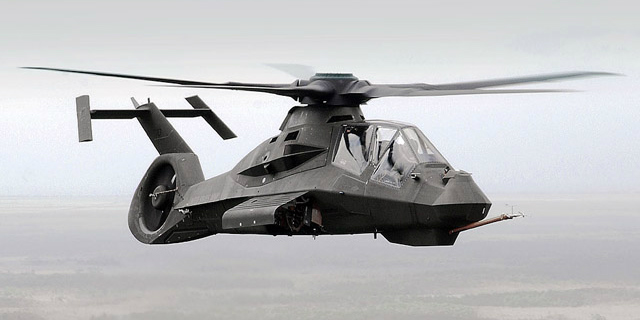The Kiowa Warrior is slated to retire in 2025, the Chinook in 2035, and both the Apache and Black Hawk will be gone by 2040. We thought we had a suitable replacement for all of these platforms in the Boeing-Sikorsky RAH-66 Comanche. But then, this next-gen stealth chopper vanished in a puff of bureaucratic smoke.
The RAH-66 Comanche would have been awesome — a veritable 21st Century Air Wolf. Designed for armed reconnaissance and assault operations, the Comanche could have done the work of both the lighter OH-58D Kiowa Warrior and the older AH-1 Cobra, but in stealth. The RAH-66 ‘s body was constructed almost entirely of radar-absorbing composite materials and shaped to minimize the helicopter’s radar cross section. On radar, the Comanche appeared 360 times smaller than the equivalently-sized AH-64 Apache. And in real life, it would have looked badass. Its five-blade main and shrouded tail rotors were also constructed from composite materials in order to minimise their noise.

The 13m long, tandem two-seater would have been powered by a pair of 1563hp turboshaft engines which provided a top speed of 323km/h and a 278km combat radius. Its avionics and navigation systems were state of the art; using digital fly-by-wire and the Helmet-Integrated Display and Sight System (HIDSS) similar to what current Typhoon pilots enjoy. And, in addition to its retractable .50 cal belly gun, the RAH-66 could also carry six Hellfires or 12 Stinger missiles in its retractable weapons pylons.
In 1983, development on a replacement to the “Vietman Era” helicopters — specifically the OH-58D Kiowa and the AH-1 Cobra — which became the basis of the Light Helicopter Experimental program. Six years of internal planning later, the Army got around to issuing a Request for Proposals and just three years after that, in 1991, the Army awarded a development contract to Boeing-Sikorsky for the production of two prototypes.
Boeing-Sikorski spent the next nine years getting the RAH-66 off the drawing board. It wasn’t until the middle of 2000 that the engineering and manufacturing phase began. And over the next four years, the team was able to produce a whopping two — count ’em, two — prototypes before the Army axed the project due to changing operational requirements.
The Army literally spent so long naval gazing at the platform that the RAH-66 became obsolete before it even got into the air. Boeing-Sikorsky was supposed to produce more than 1200 of the machines once mass production began in 2006. Nope, that’s not happening.
As Brig. Gen. Anthony Crutchfield told National Defence Magazine back in 2011,
the difficulties with new helicopter programs in the past have been that technology, as well as the needs of the service, evolve during a long, drawn-out process. Inserting new requirements in the middle of the development cycle has led to the failures.
The US Army’s R&D department wasn’t always this bogged down in red tape. The venerable UH-1 Iroquois (aka the “Huey”) helicopter took just eight years to go from drawing board to battlefield back int the ’50s. Hell, it took longer just for the RAH-66 dev team to settle on the name “Comanche.” And in the modern era, the Army’s new front line fab lab has already proved its worth pushing out vital replacement parts for forward operating bases in a matter of hours and days, not weeks and months. But that doesn’t make the loss of $US7 billion and nearly a quarter century of design work any less difficult to swallow. [Time – National Defence Magazine – Boeing – Army Tech – Wiki – GlobeSec]
Pictures: Boeing – DoD
